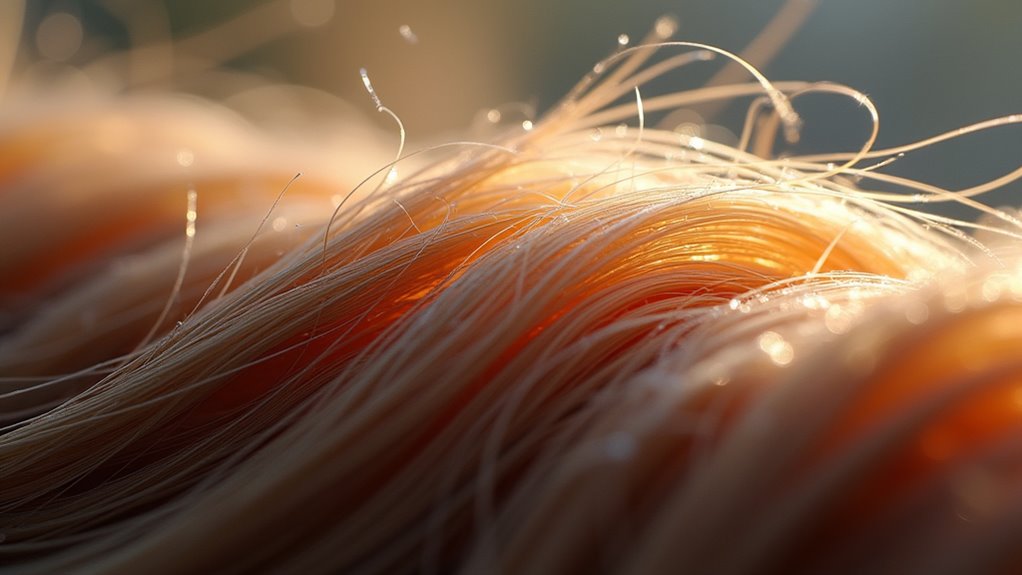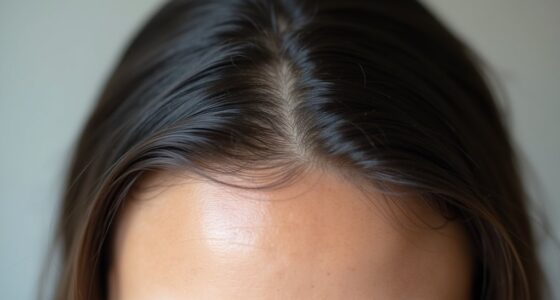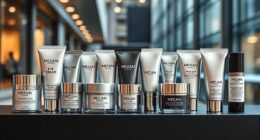Understanding your hair’s porosity helps you choose the right products and techniques to keep it healthy and moisturized. Hair porosity refers to how well your strands absorb and retain moisture, with low, high, and medium types each requiring specific care. Testing at home with simple methods like the drop test can reveal your porosity level. Knowing this enables you to tailor your routine for better hydration, less damage, and shiny, manageable hair—so stay tuned to learn more.
Key Takeaways
- Hair porosity indicates how well hair absorbs and retains moisture, affecting product choice and routine.
- There are three types: low, normal, and high porosity, each with distinct characteristics and signs.
- The drop test involves placing a hair strand in water to observe if it sinks or floats, revealing porosity level.
- Understanding your porosity helps tailor hydration, conditioning, and styling routines for healthier hair.
- Properly testing and interpreting porosity prevents product buildup and promotes scalp and hair health.
What Is Hair Porosity and Why Does It Matter?

Have you ever wondered why your hair absorbs and retains moisture differently from others? Hair porosity explains this, revealing how well your strands can take in and hold onto moisture. High porosity hair quickly absorbs products, but may also lose moisture fast, while low porosity hair resists soaking up moisture altogether. Understanding your hair’s porosity is essential, especially when choosing hair dye or caring for your scalp health. For example, high porosity hair can be more prone to damage from chemical treatments like dyeing, making proper care vital. Low porosity hair might require heat or specific products to open the cuticle. Knowing your porosity helps you select the right products and techniques, ensuring your hair remains healthy, shiny, and well-moisturized. Additionally, automation technology in hair care gadgets is increasingly used to analyze hair porosity and customize treatment plans. Recognizing Hair porosity can also guide you in selecting the appropriate styling and conditioning routines tailored to your hair’s needs.
The Different Types of Hair Porosity Explained
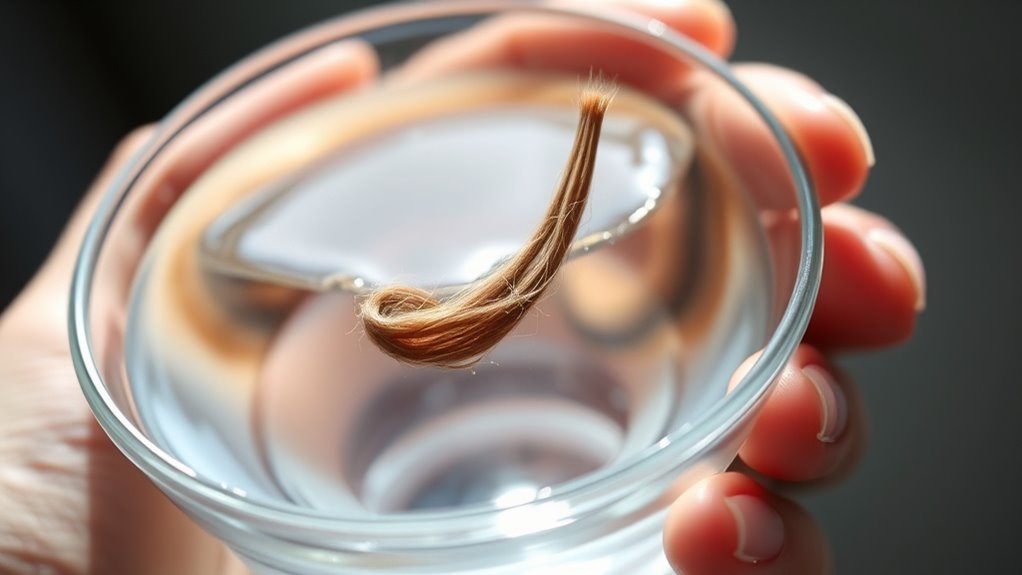
Understanding the different types of hair porosity helps you care for your hair more effectively. Low porosity hair resists moisture absorption, while high porosity hair quickly loses moisture and is more prone to damage. Recognizing these traits allows you to choose the right products and routines for healthier, better-maintained hair.
Low Porosity Characteristics
What exactly sets low porosity hair apart from other hair types? It’s characterized by tightly bound hair cuticles that lay flat, making moisture retention a challenge. This hair type resists absorbing products and water, often resulting in buildup if not properly cared for. Additionally, the use of natural and organic juices can help improve hydration and overall scalp health. Using appropriate hair products that are lightweight and water-based can further aid in moisture absorption. Properly understanding hair porosity can guide you toward better hair care practices. Here are three key traits of low porosity hair:
- Hair cuticles are compact and smooth, preventing easy penetration.
- Water tends to bead on the surface rather than soaking in.
- It takes longer to dry, as moisture struggles to enter the strands.
High Porosity Traits
High porosity hair is characterized by cuticles that are often damaged or lifted, allowing moisture to enter and escape easily. This trait is common in people with certain hair colors, like bleached or chemically processed hair, which tend to have higher porosity. Because the cuticles are more open, your hair can quickly absorb products but also lose moisture just as fast, leading to dryness and frizz. High porosity can also impact scalp health, making it prone to dryness or irritation if moisture isn’t properly balanced. You might notice your hair feels brittle or appears dull, especially if your hair color has been lightened or chemically treated. Additionally, using the right moisturizing products can help restore balance and improve your hair’s condition. Understanding these traits helps you choose the right products to restore moisture and improve your scalp’s health, especially when selecting appropriate hair treatments tailored to high porosity hair. Incorporating moisture-retention techniques into your routine can further enhance your hair’s health and resilience. Regularly using deep conditioning masks can further enhance moisture retention and overall hair health.
How to Test Your Hair’s Porosity at Home
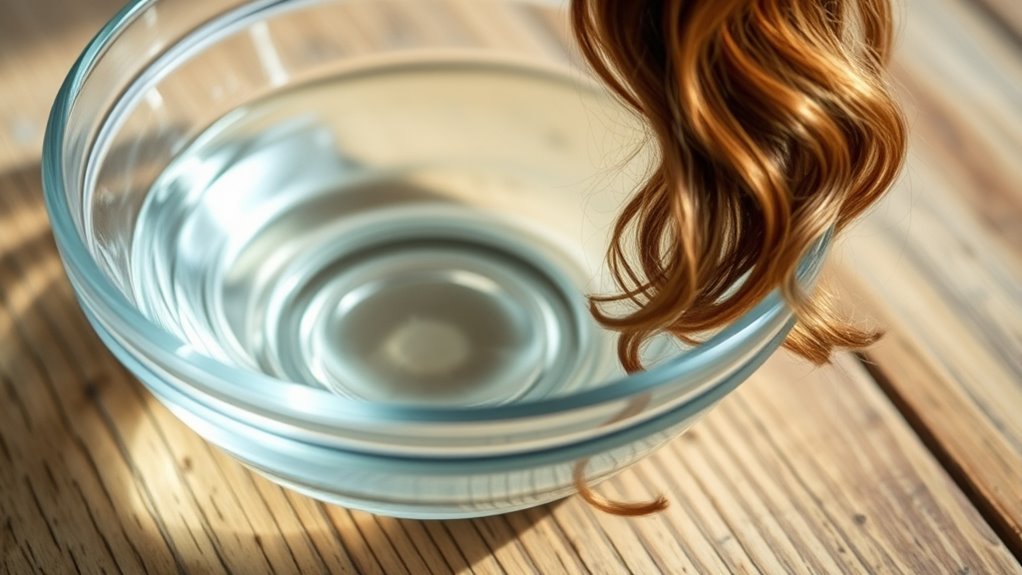
To test your hair’s porosity at home, start by gathering simple materials like a glass of water and a few strands of clean hair. Next, conduct the drop test by placing a strand in the water and watching how quickly it sinks or floats. Be sure to interpret your results carefully to determine your hair’s porosity level accurately. Additionally, understanding your hair’s porosity can help you choose the right hair care products and treatments to improve its health and appearance.
Gather Testing Materials
Before you begin testing your hair’s porosity at home, gather a few simple materials. This DIY testing requires only basic items to help you determine your hair’s absorption rate. First, you’ll need a clear glass or plastic cup filled with room-temperature water. Second, grab a strand of clean, dry hair, preferably a few inches long. Lastly, have a timer or stopwatch ready to track how quickly the hair sinks. These materials are essential for a straightforward, at-home product selection process. Making sure you have everything beforehand ensures a smooth testing process. Understanding hair porosity is crucial for selecting the right hair care products and maintaining healthy hair. With these tools, you can confidently assess your hair’s porosity without needing professional equipment, empowering you to choose the best products for your hair type.
Conduct the Drop Test
Once you have your materials ready, gently place the strand of clean, dry hair into the water, ensuring it’s fully submerged. Watch how it reacts over the next few minutes. If your hair sinks quickly, it indicates low porosity, meaning less hair absorption. If it floats at the top, it suggests high porosity, which allows for more absorption but can cause moisture loss. Medium-paced sinking indicates normal porosity, balancing absorption and retention. Monitoring how your hair reacts can also help you identify hair porosity testing methods and AI safety concerns related to hair care products and routines. Understanding your hair’s electric properties can further guide appropriate treatments and prevent damage. Knowing your natural hair texture can also influence your choice of styling and care techniques.
Interpret Results Carefully
Interpreting your hair’s porosity results requires careful observation and understanding of what each response means. Many people fall for porosity myths, believing certain results are always good or bad, but hair porosity myths can be misleading. To accurately assess your hair’s porosity, consider these tips:
- Look beyond stereotypes—low porosity isn’t always better, and high porosity isn’t necessarily worse.
- Combine test results with how your hair feels and reacts to products for a complete picture.
- Stay cautious of porosity myths that oversimplify hair health, and remember each person’s hair is unique.
Signs of High, Medium, and Low Porosity Hair
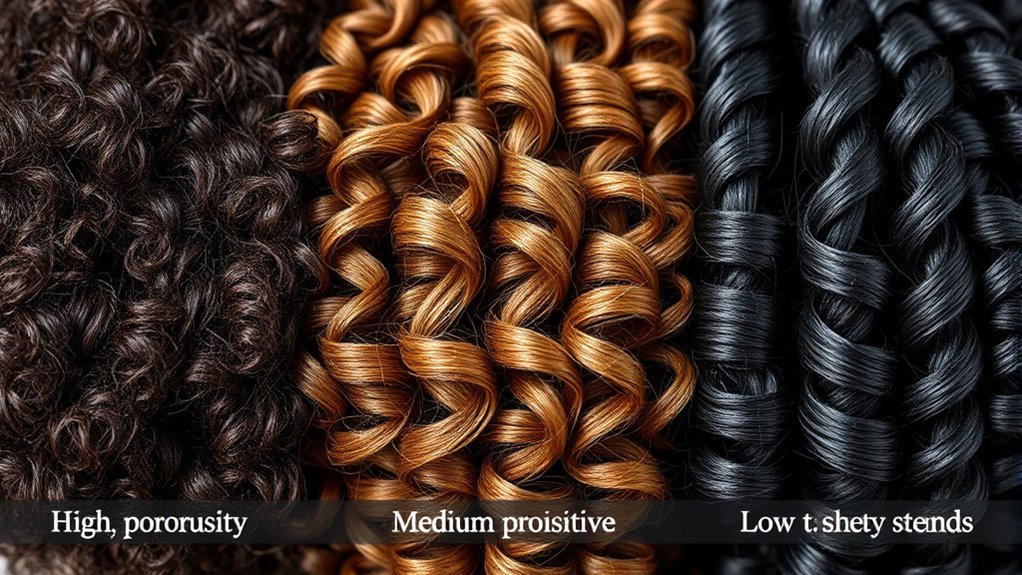
Understanding the signs of your hair’s porosity can help you choose the right hair care routine. High porosity hair often struggles with moisture retention, drying out quickly and feeling brittle. You might notice frizz and excessive tangling, and your scalp could be prone to dryness or buildup. Regular dental check-ups are recommended for overall health, which parallels the importance of maintaining scalp health in hair care routines. Your scalp usually feels healthy, and your hair responds well to moisturizing products. Additionally, using the right hair porosity test can help you determine your hair’s specific needs and avoid product buildup or insufficient moisture absorption. Recognizing these signs helps you tailor your routine for ideal scalp health and moisture management. Incorporating proper cleansing methods can also prevent product buildup and keep the scalp balanced, especially for high porosity hair. Understanding hair porosity can also guide you in selecting suitable styling and treatment options that enhance your hair’s natural properties. Low porosity hair resists moisture absorption, often appearing shiny and smooth but sometimes feeling weighed down or greasy. It dries slowly and may require heat or specific products to open the cuticles. Recognizing these signs helps you tailor your routine for ideal scalp health and moisture management.
Hair Care Tips for Each Porosity Type
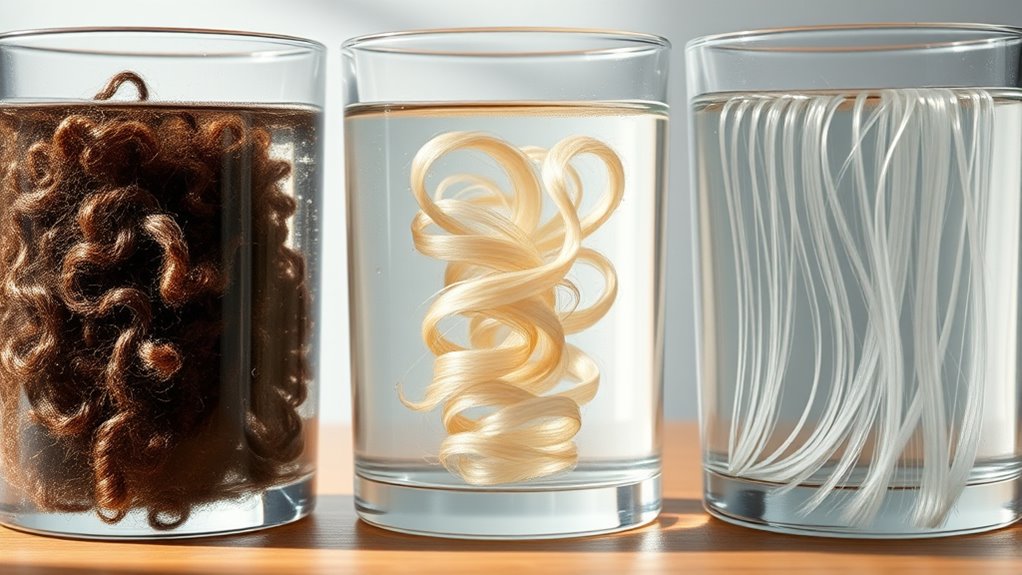
Knowing your hair’s porosity helps you select the best products and techniques to keep your hair healthy. For high porosity hair, focus on deep conditioning and sealing moisture with oils. When hair dyeing, use gentle, hydrating dyes to prevent damage, and incorporate scalp massages to boost circulation. Additionally, understanding hybrid tuning concepts can inspire innovative approaches to hair care routines, ensuring optimal results. Medium porosity hair benefits from regular clarifying shampoos and lightweight leave-in conditioners, which help maintain balance. For low porosity hair, avoid heavy products; instead, opt for lightweight liquids and heat-activated treatments. To keep your scalp healthy, give it gentle massages regularly, and choose dyes designed for low porosity hair to prevent buildup. Understanding your appliance maintenance plans can also help you maintain your hair tools and accessories, ensuring they stay in optimal condition for styling. Adjust your routine based on your porosity for ideal hair health and vibrancy.
Products That Work Best for Your Hair Porosity

Choosing the right products for your hair porosity can make a significant difference in maintaining healthy, vibrant hair. For high porosity hair, use lightweight, hydrating products that seal moisture without weighing hair down. Low porosity hair benefits from clarifying shampoos and heat-activated treatments to open cuticles for better absorption. Medium porosity hair responds well to balanced moisture and protein treatments. Prioritize products that support scalp health, especially if you color your hair, as coloring can weaken strands.
| Porosity Level | Recommended Products |
|---|---|
| High Porosity | Leave-in conditioners, oils, sealing serums |
| Medium Porosity | Moisturizing shampoos, light creams, protein treatments |
| Low Porosity | Clarifying shampoos, heat-activated treatments, humectants |
Maintaining Healthy Hair Based on Your Porosity Level
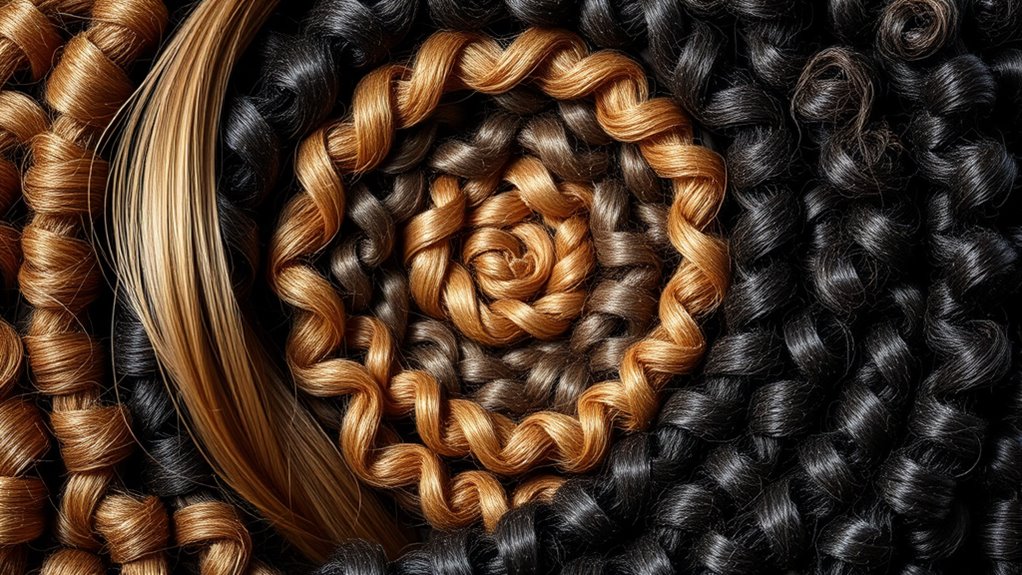
To keep your hair healthy, you need to tailor your hair care routine to your porosity level. Understanding whether your hair is low, medium, or high porosity helps you choose the right products and techniques. For example, if you have high porosity hair, focus on sealing moisture with natural oils like argan or coconut oil to prevent damage. For low porosity hair, use lightweight, water-based products to avoid buildup. Medium porosity hair benefits from a balanced routine that maintains scalp health and moisture.
Here are three tips:
- Regularly massage natural oils into your scalp to promote scalp health.
- Use heat or steam treatments to open cuticles or lock in moisture.
- Avoid harsh shampoos that strip natural oils, regardless of porosity.
Frequently Asked Questions
How Does Hair Porosity Affect Color Retention and Fading?
Your hair’s porosity directly impacts color retention and fading. Higher porosity means your hair absorbs color easily but also loses it quickly, leading to faster fading. Low porosity resists color uptake, so your hair may not hold dye well, resulting in duller shades over time. By understanding porosity and color, you can choose better products and treatments to enhance longevity and minimize fading, keeping your hair vibrant longer.
Can Hair Porosity Change Over Time or With Treatments?
Yes, your hair’s porosity can change over time due to porosity fluctuation and treatment effects. Factors like chemical treatments, heat styling, and environmental exposure can alter the cuticle’s condition, making your hair more or less porous. Regular treatments like deep conditioning or protein masks can help improve porosity, while over-processing might increase it. Keep checking your hair’s response to maintain ideal health and color retention.
Is Hair Porosity Different for Natural Versus Chemically Treated Hair?
Think of natural hair and chemically treated hair as two different landscapes—one untouched and wild, the other altered by human hands. Chemically processed hair often has higher porosity because chemical treatments open up the cuticles, making it more prone to damage and moisture loss. In contrast, natural hair generally has lower porosity, retaining moisture better. Your hair’s porosity depends on its history, with chemical processing often increasing its porosity.
How Does Climate Influence Hair Porosity and Health?
Climate impact and seasonal changes can profoundly affect your hair’s porosity and health. Humid weather causes hair to absorb more moisture, increasing porosity and making it prone to frizz, while dry, cold seasons can lead to dehydration and brittleness. You’ll notice your hair reacts differently across seasons, so adjusting your hair care routine accordingly helps maintain healthy, balanced hair and manages porosity effectively throughout the year.
Are There Specific Hairstyles Better Suited for Different Porosity Levels?
Oh, sure, you should just pick any hairstyle you like, right? Well, not quite. For different porosity levels, you’ll want porosity-specific styles that enhance your hair’s natural traits. Low porosity loves styles that allow moisture to penetrate, while high porosity benefits from protective hairstyles that lock in hydration. So, yes, hairstyle compatibility matters, and choosing the right style makes your hair look better and stay healthier.
Conclusion
Understanding your hair’s porosity might seem unnecessary, but it truly makes a difference in your hair care routine. Knowing your porosity helps you choose the right products and treatments, saving time and preventing damage. Think it’s too complicated? It’s easier than you think—and your hair will thank you for it. Take a quick test today and start giving your hair the care it needs to stay healthy, shiny, and vibrant.
